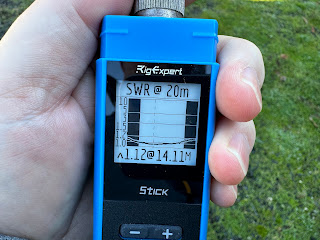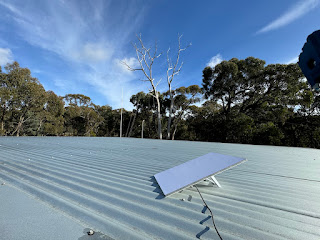After posting the last story on my very simple end fed half wave antenna I received some suggestions for improvement from Richard, VK3TXD. In the past he has sent me some antennas and match boxes he has constructed. He was concerned that if he left this as a comment I might take it as heavy criticism, but no, I am very grateful for his suggestions.
Richard writes:
Some suggestions for you. In no particular order. Some terse notes. Do feel free to query, happy to discuss.
1. Check toroids before use. The Jaycar ones often have a sharp lip. Sand it off with emery type paper. Sharp lips are the enemy of enamel wire.
2. The cap. You mentioned HV. My experience with the altronics ones was poor. They were super lossy. I strongly suggest Silver mica. 500V is good for 100W and more. No need for higher.
VNA measurement will show the difference easily.
You used 150pf. That looks a little high.
3. I used 0.8mm diam enamel wire for 100W. I use 0.63 wire for 50W. Not sure what you used. Using 1mm or more is pointless. [I used 0.63mm]
4. The LO1238 is quite good. If anyone criticises you and says you should use a Fairrite core or similar, ask if they've done measurements. I have. The differences are within margins too close to error. Some people say you should use #52 or other material. Same come back.
5. Spread out winding increases loss. It makes flux linkage between turns more difficult. Close wind. Shorter magnetic paths are better in all regards.
6. 2 turn primary tapping is not good. For 160m, 80m, 40m, the efficiency will be really poor. On 10m it starts to come good. Use a 3 turn primary. <<-- please test with VNA, the difference is quite surprising.
One thing. On 10m the 3 turn primary may be fractionally worse on 10m. On all other bands the loss will be substantially less.
With 3 turn primaries, 160m and 80m are ok.
7. Teflon tape wrapping the toroid is pointless. Some people have a fetish for it. It will make the experimenter _feel_ good, but at 100W, it makes zero difference - I've not had flashover ever and never used tape. I think I've sold about 70 UnUns using the same toroid.
8. At 400W, yes, 400W, the 100pF 500v silver mica cap will fail. A user admitted that. I _really_ don't recommend it. I am not convinced the EFHW is a good solution to > 100W as the electric field will be very high, and the instantaneous voltage on the hot end of the UnUn will get disgusting-high.
9. Be prepared to need a 1:1 to tame the common mode current. The unit I sent you has an inbuilt 1:1. It is not perfect, the coax sits in the high intensity field, but no user has reported a problem.
Craig VK3NCR tried a 1st version without the 1:1 and on 10W from his IC705 it garbled voice peaks. His radio hated it. The 2nd version with 1:1 cured it.
1:1 baluns and common mode current seems to be a dirty little secret few own up to.
10. On 13th May for a few days Stan VK3BOT is going mobile. He is using my UnUns. https://www.vk3frc.org.au/post/an-invitation if you get a chance to have a QSO and mention me. VK3NCR and VK3BOT
11. There are some other good options for toroids......
Try stacking 2 LO1234's = super glue together. This has a shorter magnetic path and the efficiency is quite a bit better than the LO1238. How much better.....use the VNA <smile> This one is in fact my favourite,
Try stacking 3 of the LO1230 (smaller ones) and use 0.63mm wire. I put 50W into these. These are very efficient also. I did a mounting sled for use in a jiffy box. It is quite good.
12. Oh. On YouTube checkout "mm0opx" - he's done a lot of work. Also "evil lair electronics". And "Steve Ellingtn" has a nice video on the small compensation coil you can use to make the bands line up better.
13. I've not really mentioned my thoughts on efficiency and antenna mounting. Let me know if you are interested. The above data-dump is a bit intense for now.
14. My favourite so far. The 2 stack LO1234.
Tech notes.
The smaller diameter has a shorter magnetic path which aids efficiency. Being taller helps increase the magnetizing impedance but not so much as to make 10m unusable.
Below is based on 2 stack LO1234 UnUn with 2 stack 1:1 as well. It goes into a rather nice and small box. Stan and Craig have them now. Drilling the ends is disgusting, it is super tight tolerance so I made drilling templates. I'm happy to send you files if you want - personal use etc. Oh. I've been using some stainless wing nuts and bolts recently. Some users want them.
My sincere thanks to Richard for his detailed feedback and suggestions. I will certainly try some of them.
I put up the antenna this afternoon and had a QRP contact on 20m with a station west of Sydney (about 800km away). I mentioned this to Richard who replied:
Having success with a home built antenna is THE BEST isn't it. I find it a pleasure. I bet you smiled! <I would have>
The resonance moving up the band to 100% normal and caused by capacitive coupling being frequency dependent (don't quote me on that)...as F goes up, more coupling to ground hence resonance goes up. Something like that.
That
Steve Ellington Video I mentioned. Chase that down. Seriously. He explains it well and a small loading coil 2m from the UnUn will fix it <<<---worthwhile (and fun). I use some 19mm (?) placcy pipe and about 8 to 10 turns.
Why 2m along? Steve explains. It is all to do with the current profile moving by each band and hence the loading coil has a different effect by band. You can get it quite close to spot on.
One thing. The SWR being that low quite often means there is a fair amount of loss in both efficiency of the UnUn, but also in radiation. Unless noted, your coax will be on the ground and its outer sheath is acting as the radial and radiating into....the ground. Hence loss.
I've nec modelled the EFHW. Very naive models tho. A good thing about it is that on 40m, wth 20m of wire, the point of highest current is 1/2 way up the wire. If you are using a 9 or 10m squid pole and inverted L, it is nice and high in the air and the pattern is quite NVIS. On 20m, the high current point is lower and it looks more like a vertical with lower lobes, hence you get the best of both worlds - 40m NVIS and 20m DX. It all depends on mounting etc of course.
I like to have the 1:1 in the same box and use 2, yes 2, radials. I found the SWR was better. I mount in inverted-L with a 1 to 1.5m elevation of the unun. The radials radiate, so get them into the air.
That capacitor looks good actually! It may be a SM type. In truth...this only comes into play marginally on 20m rising to significantly on 10m.
The spec-an if it has a tracking generator can do a loss measurement. The nanovna can save the file tho. The spec-an may offer it - I don't know.
You can open a .s2p file with a text editor. It is just all the measurements that were used to plot the data. It is in complex (real imaginary - or real and phase angle) format. See Dan's post on the math.
On the NanoVNA. Download a PC program (or mac?) and use that connected to the nanovna. That will have a means to save the data to file. It is of type ".s2p" and from that I can plot swr and loss with the code I wrote with help from Dan as mentioned.
Use the 'logmag S21' test - and be sure to calibrate and use the same fly leds in the calibration. Accurate measurement is not a trivia exercise.
NOTE....the 50 ohm side pigtails can make a big difference to SWR. I've found keeping these short makes a big difference..
The ohm meter test is all very well, but the EFHW can have quite high voltages on the top end of the UnUn. The ohm meter is not great for this kind of test, you are not testing with what it will experience. That is why at 400W I would get nervous. At 100W the voltage should be less than 500V even under an adverse SWR.
Ta on the neatness. I have wound many. Using 0.8mm wire makes it a lot easier.
Efficiency....the worst balun you could possibly make will have loss up in the 3db region, so losing 50% of the power. This will be turned to heat in the ferrite core. You might juuuuust her that kind of loss.
Guess, but from experiments, on 40m a 2 turn primary may have round 40% loss worst case. The 3 turn primary halves that and slightly better. The stack of LO1234s is a bit better again.
I tried stacking LO1238's. That helped on 160 and 80 and 40. On 20m it was worse than 1 core and on 10m it was terrible. Looks good tho!
The hard truth. You won't hear the difference unless it is a marginal signal on SSB. A more efficient UnUn will get less hot, so even on 10W it will run a little cooler. SSB is very lenient. All change if you use digital. It makes a huge difference there. Core heating under digital can be over 10 times, and maybe 20 times more than SSB because of higher average power.
Feel free to publish. A very small mention would be fine. I'm sure you will write it better than me. You can make a few posts out of it exploring that compensation coil, and trialling the smaller 2 stack, and loss testing etc. I've spent a lot lot lot of time playing with all this.
Gotta go. I'm cooking dinner!
Cheers - Richard




































